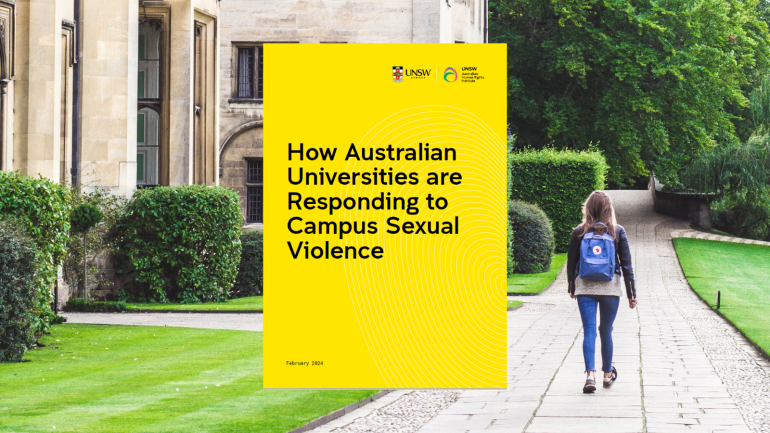A new report tracking Australian university responses to campus sexual violence has highlighted the need for more transparent data reporting.
How Australian Universities are Responding to Campus Sexual Violence, released by the Australian Human Rights Institute at UNSW Sydney, collates institution-specific information drawn from university websites, as at February 2024. It includes relevant university policies and governance information, links to institutional reports about disclosures of sexual violence, and access to institutional data about the prevalence of sexual violence (as identified in the two national student safety surveys, where available).
Australian Human Rights Institute Research Fellow Dr Allison Henry said that the report would be an important resource leading into the 2024 academic year.
“Throughout 2023 we were repeatedly asked by members of the University Accord, parliamentarians and student leaders about which universities were ‘doing well’ in responding to campus sexual violence,” Dr Henry said.
“Providing a full national picture has been very difficult. While many of Australia’s universities have taken concerted action to tackle sexual violence over recent years, the national higher education regulator, TEQSA, has not undertaken any systemic oversight of these efforts since July 2020.”
The profiles contained in the report highlight that while most universities are proactive in making information about their policies and reporting mechanisms visible, many are far less transparent about their reporting data.
“The experience of students subjected to sexual violence is the key factor in assessing individual university responses and requires further research”, Dr Henry said.
“It is therefore disappointing that only 15 of Australia’s universities are publishing any consolidated information about the reports or disclosures of sexual violence they receive and that even fewer are transparently reporting about how the university responds – investigation outcomes and what disciplinary measures may have been utilised.
“It is also troubling that only three of the 39 universities who participated in the 2021 National Student Safety Survey had made their detailed reports publicly available on their websites.”
Our findings
- Nearly all Australian universities now have stand-alone policies on sexual violence. Most are clearly and appropriately named, though the terms used vary between institutions (e.g. sexual violence, sexual harm, sexual misconduct).
- Only 15 universities have current action plans or strategies targeting sexual or gender-based violence.
- Most universities have online reporting mechanisms, with an opportunity for anonymous reporting in many cases. A majority also provide information about what will happen once a disclosure or report is made to the university.
- Nearly all Australian universities have clear guidance on how students or staff who have been subjected to sexual violence can access internal and external support services.
- A third of Australia’s universities do not have standing governance mechanisms in place, such as internal taskforces, steering or advisory committees, to ensure a consistent ongoing focus on sexual violence.
- There is a lack of clarity in some university reporting procedures about the difference between concerns, disclosures, reports and complaints, and a lack of consistency across universities in the use of these terms.
The report does not attempt to assess or comment on the effectiveness of the initiatives listed, noting that the existence of a policy or strategy does not necessarily indicate that a university’s response is evidence-based or good practice, or that initiatives are adequately resourced. Rather, the report provides links to publicly available information so that students can find and assess what is happening at their university.
Further reading
- A snapshot of Australian university responses to campus sexual violence, Dr Allison Henry, Alternative Law Journal (open access).
